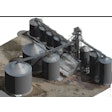
Welcome to the February/March 2016 issue of Feed & Grain — one of our largest ever! In its pages, you’ll find information on products, services, equipment and trends for grain handling professionals, in addition to an extensive preview of the grain handling industry’s largest annual trade show and conference — GEAPS Exchange 2016. If you’re like many in the grain handling industry, soon you’ll be heading to Austin, TX, for the big show, hosted by the Grain Elevator and Processing Society (GEAPS).
There, dozens of educational sessions are planned to keep you informed on the latest in grain quality management, risk management, grain handling safety, federal agency regulations affecting our industry, and more. See pg. 14 for details about this upcoming event.
Taking a cue from GEAPS Exchange, grain handling is a theme throughout this issue, as demonstrated by the Product Spotlights on Storage (pg. 34) Safety and Rescue (pg. 64) and Drying & Aeration (pg. 100), as well as our facility profile on CHS Larsen Cooperative’s two newly expanded grain terminals in central Wisconsin (pg. 28).
Between the two upgrades, CHS Larsen added nearly 1 million bushels of storage capacity and three new state-of-the-art dryers, meeting their farmer-members’ needs for more speed, drying efficiency and space.
But in addition to covering the “nuts and bolts” of grain handling, we know that managing people is among one of your toughest ongoing responsibilities.
We hope to help you address some of these everyday challenges with the time management advice in Manager’s Notebook (pg. 44) — Tackle the Big Hard Stuff, Not the Easy Little Stuff — and the safety tips in Five Key Tactics for Keeping Employees Safe (pg. 66). These two critical issues go hand in hand because no matter how crunched for time we are, safety should always be regarded as the highest priority.
Another difficult aspect of management, although we don’t like to admit it, is dealing with people who are different from ourselves — like millenials, for example. We delved into this topic with How to Manage Generational Differences in the Workplace (pg. 72).
You might be surprised to hear that there could be up to four generations of Amercians in one workplace. But just because every generation has unique values and habits, that doesn’t mean they can’t all be an intregal part of your company’s team.
So, whether you’re handling grain or handling people — or both — we’ve got you covered!












